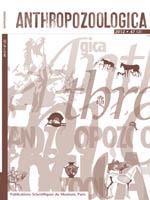M. Salque, G. Radi, A. Tagliacozzo, B. Pino Uria, S. Wolfram, I. Hohle, H. Stäuble, D. Hofmann, A. Whittle, J. Pechtl, S. Schade-Lindig, U. Eisenhauer, R.P. Evershed
Anthropozoologica 47 (2), 45-62, (1 December 2012) https://doi.org/10.5252/az2012n2a4
KEYWORDS: European prehistory, NEOLITHIC, pottery vessels, sieves, lipids, Fatty acids, δ13C values, animal products, milk, Préhistoire européenne, Néolithique, tessons de poterie, faisselles, lipides, acides gras, valeurs de δ13C, produits animaux, lait
Analyses of organic residues preserved in ceramic potsherds enable the identification of foodstuffs processed in archaeological vessels. Differences in the isotopic composition of fatty acids allow differentiation of non-ruminant and ruminant fats, as well as adipose and dairy fats. This paper investigates the trends in milk use in areas where sheep and goats are dominant in the faunal assemblage and in some sites from the Linearbandkeramik culture. Sites include: Colle Santo Stefano, Abruzzo, Italy, and the Oldest to Young Linearbandkeramik sites of Zwenkau, Eythra and Brodau, Saxony, and Wang and Niederhummel, Bavaria, Germany. More than 160 potsherds were investigated including cooking pots, bowls, jars, and ceramic sieves. The lipid residues presented provide direct evidence for the processing of ruminant and non-ruminant commodities at Zwenkau and Eythra, despite the absence of faunal remains at the sites. No dairy residues were detected in potsherds from LBK sites, except in a ceramic sieve at Brodau. Lipids from non-ruminant and ruminant fats, including from dairy fats, were detected at the site of Colle Santo Stefano showing a reliance on dairy products during the first half of the sixth millennium at this site; where sheep and goats were the major domestic animals.

